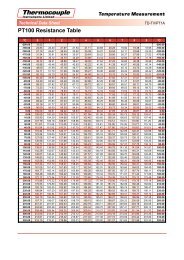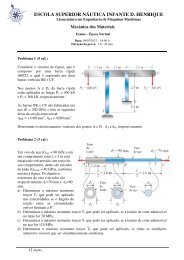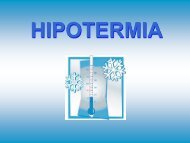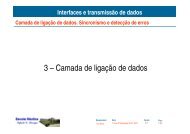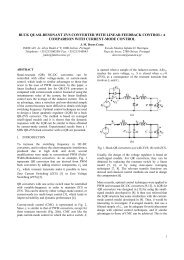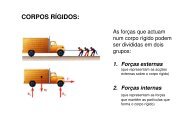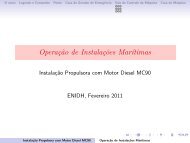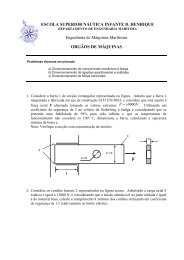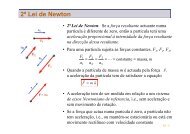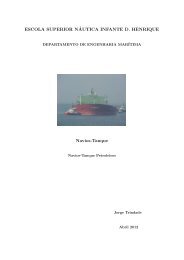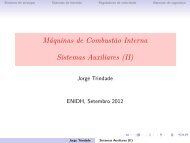Textos de Apoio (pdf)
Textos de Apoio (pdf)
Textos de Apoio (pdf)
You also want an ePaper? Increase the reach of your titles
YUMPU automatically turns print PDFs into web optimized ePapers that Google loves.
Power<br />
Engine margin<br />
(10% of MP)<br />
Sea margin<br />
(15% of PD)<br />
2 6<br />
Continuous service propulsion point SP<br />
The resulting speed and power combination<br />
– when including heavy propeller<br />
running and sea margin – is called the<br />
“continuous service rating for propulsion”<br />
SP for fouled hull and heavy weather.<br />
The heavy propeller curve, curve 2, for<br />
fouled hull and heavy weather will normally<br />
be used as the basis for the engine<br />
operating curve in service, and the<br />
propeller curve for clean hull and calm<br />
weather, curve 6, is said to represent a<br />
“light running” LR propeller.<br />
LR(5%)<br />
HR<br />
SP<br />
Fig. 17: Ship propulsion running points and engine layout<br />
MP<br />
PD´<br />
Engine speed<br />
2 Heavy propeller curve<br />
_<br />
fouled hull and heavy weather<br />
6 Light propeller curve<br />
_<br />
clean hull and calm weather<br />
MP: Specified propulsion point<br />
SP: Service propulsion point<br />
PD: Propeller <strong>de</strong>sign point<br />
Pd´: Alternative propeller <strong>de</strong>sign point<br />
LR: Light running factor<br />
HR: Heavy running<br />
PD<br />
Continuous service rating S<br />
The continuous service rating is the<br />
power at which the engine, including<br />
the sea margin, is assumed to operate,<br />
and point S is i<strong>de</strong>ntical to the service<br />
propulsion point SP unless a main engine<br />
driven shaft generator is installed.<br />
Light running factor f LR<br />
The heavy propeller curve for a fouled<br />
hull and heavy weather, and if no shaft<br />
generator is installed may, as mentioned<br />
above, be used as the <strong>de</strong>sign basis for<br />
the engine operating curve in service,<br />
curve 2, whereas the light propeller<br />
curve for clean hull and calm weather,<br />
curve 6, may be valid for running conditions<br />
with new ships, and equal to<br />
the layout/<strong>de</strong>sign curve of the propeller.<br />
Therefore, the light propeller curve<br />
for clean hull and calm weather is said<br />
to represent a “light running” LR propeller<br />
and will be related to the heavy<br />
propeller curve for fouled hull and<br />
heavy weather condition by means of a<br />
light running factor f LR<br />
, which, for the<br />
same power to the propeller, is <strong>de</strong>fined<br />
as the percentage increase of the rate<br />
of revolution n, compared to the rate of<br />
revolution for heavy running, i.e.<br />
f<br />
LR<br />
n<br />
=<br />
light<br />
− n<br />
n<br />
heavy<br />
heavy<br />
×100%<br />
Engine margin<br />
Besi<strong>de</strong>s the sea margin, a so-called<br />
“engine margin” of some 10-15% is<br />
frequently ad<strong>de</strong>d as an operational<br />
margin for the engine. The corresponding<br />
point is called the “specified MCR<br />
for propulsion” MP, see Fig. 17, and<br />
refers to the fact that the power for<br />
point SP is 10-15% lower than for<br />
point MP, i.e. equal to 90-85% of MP.<br />
Specified MCR M<br />
The engine’s specified MCR point M is<br />
the maximum rating required by the<br />
yard or owner for continuous operation<br />
of the engine. Point M is i<strong>de</strong>ntical to the<br />
specified propulsion MCR point MP unless<br />
a main engine driven shaft generator<br />
is installed. In such a case, the extra<br />
power <strong>de</strong>mand of the shaft generator<br />
must also be consi<strong>de</strong>red.<br />
Note:<br />
Light/heavy running, fouling and sea<br />
margin are overlapping terms.<br />
Light/heavy running of the propeller refers<br />
to hull and propeller <strong>de</strong>terioration,<br />
and bad weather, and sea margin, i.e.<br />
extra power to the propeller, refers to<br />
the influence of the wind and the sea.<br />
Based on feedback from service, it<br />
seems reasonable to <strong>de</strong>sign the propeller<br />
for 3-7% light running. The <strong>de</strong>gree<br />
of light running must be <strong>de</strong>ci<strong>de</strong>d<br />
upon, based on experience from the<br />
actual tra<strong>de</strong> and hull <strong>de</strong>sign, but 5%<br />
is often a good choice.<br />
21


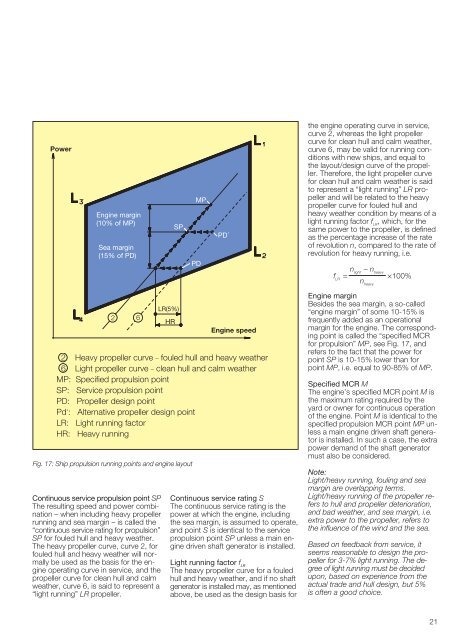
![Conceitos transmissao de dados .Sinais[.pdf]](https://img.yumpu.com/50982145/1/190x146/conceitos-transmissao-de-dados-sinaispdf.jpg?quality=85)
![Packages e interfaces[.pdf]](https://img.yumpu.com/50629553/1/190x134/packages-e-interfacespdf.jpg?quality=85)
